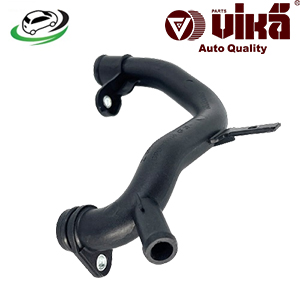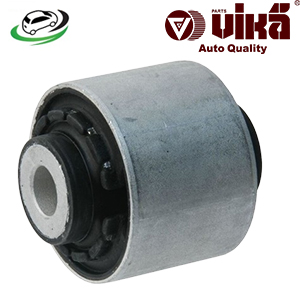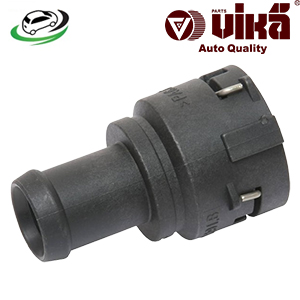-37%
Get Heater Hose Connector AUDI A1/A3/Q3/TT / VW Bora/Beetle/Caddy CC EOS/Golf/Jetta/Passat/Tiguan 3B0122291B
The heater hose connector is a critical component in a vehicle’s heating system. It serves as a junction point where heater hoses, which carry coolant to and from the heater core, are connected. Understanding its function, types, benefits, and maintenance can help ensure the effective operation of the vehicle’s heating system and prevent potential issues.
Function of the Heater Hose Connector
- Fluid Transport:
- Primary Role: The heater hose connector facilitates the flow of coolant between the engine and the heater core.
- Mechanism: Coolant circulates through the heater hoses connected by the heater hose connector, allowing the heater core to receive hot coolant and emit heat into the cabin.
- System Integration:
- Primary Role: It integrates the heater hoses with other components of the cooling system.
- Mechanism: The connector ensures a secure and leak-proof connection, enabling efficient transfer of coolant and consistent heating performance.
- Pressure Maintenance:
- Primary Role: The heater hose connector helps maintain the necessary pressure within the heating system.
- Mechanism: By securely sealing the connection between the hoses, the connector supports the overall pressure and efficiency of the heating system.
- Temperature Regulation:
- Primary Role: The connector contributes to regulating the temperature of the coolant circulating through the heater core.
- Mechanism: Proper flow and connection ensure that the heater core receives adequately heated coolant to provide effective cabin heating.
Types of Heater Hose Connectors
- Barbed Connectors:
- Description: Barbed connectors have ridges or “barbs” that grip the inside of the heater hose to create a secure seal.
- Advantages: Simple design and easy installation with a reliable connection.
- Disadvantages: Over time, barbs can become worn or damaged, potentially leading to leaks.
- Push-On Connectors:
- Description: Push-on connectors feature a design that allows the hose to be pushed onto the connector without the need for clamps.
- Advantages: Quick and easy to install, often used in modern vehicles for simplicity.
- Disadvantages: May require specific conditions to ensure a secure fit and may not be as robust as other types.
- Clamp-On Connectors:
- Description: These connectors use clamps or bands to secure the hose onto the connector.
- Advantages: Provides a strong and secure connection with the ability to adjust the tightness.
- Disadvantages: Installation requires the use of clamps, which may need periodic adjustment.
- Threaded Connectors:
- Description: Threaded connectors screw into place, creating a secure connection with threaded fittings on the heater hoses.
- Advantages: Offers a very secure and leak-proof connection.
- Disadvantages: Installation can be more time-consuming and may require tools.
- Quick-Disconnect Connectors:
- Description: Quick-disconnect connectors are designed for easy removal and reattachment, often used in systems requiring frequent maintenance.
- Advantages: Facilitates quick and convenient disconnection and reconnection.
- Disadvantages: May be more complex and expensive compared to standard connectors.
Benefits of Properly Functioning Heater Hose Connectors
- Effective Cabin Heating:
- Benefit: Properly functioning connectors ensure that the heater core receives a consistent flow of hot coolant, providing effective heating inside the cabin.
- Explanation: This maintains a comfortable temperature for the occupants, especially in cold weather.
- Preventing Coolant Leaks:
- Benefit: A secure and leak-proof connection prevents coolant from escaping the system.
- Explanation: Preventing leaks helps maintain proper coolant levels, avoiding overheating and ensuring efficient operation of the heating system.
- Enhanced System Efficiency:
- Benefit: Proper connectors contribute to the overall efficiency of the heating system by maintaining optimal coolant flow and pressure.
- Explanation: Efficient operation reduces strain on the engine and heating components, improving overall performance.
- Extended Component Lifespan:
- Benefit: A well-maintained heater hose connector helps protect other components of the cooling and heating system from wear and damage.
- Explanation: By ensuring proper connections, the connector supports the longevity and reliability of the entire system.
- Reduced Maintenance Costs:
- Benefit: Properly functioning connectors reduce the likelihood of leaks and associated repairs.
- Explanation: Maintaining secure connections minimizes the need for frequent repairs and replacements, reducing overall maintenance costs.
Symptoms of a Faulty Heater Hose Connector
- Coolant Leaks:
- Symptom: Visible coolant puddles or drips under the vehicle, especially near the heater core or hose connections.
- Cause: A faulty or damaged connector may allow coolant to leak out.
- Consequence: Coolant loss can lead to overheating, reduced heating performance, and potential engine damage.
- Reduced Cabin Heat:
- Symptom: Insufficient heat or cold air blowing from the heater vents.
- Cause: A faulty connector may disrupt the flow of hot coolant to the heater core.
- Consequence: Reduced cabin heating affects comfort, especially in cold weather.
- Overheating Engine:
- Symptom: The engine temperature gauge shows higher-than-normal readings, or the engine overheats.
- Cause: A faulty connector can lead to coolant flow issues, affecting engine cooling.
- Consequence: Overheating can cause significant engine damage and reduced performance.
- Unusual Noises:
- Symptom: Hissing or gurgling noises from the engine bay.
- Cause: Air trapped in the cooling system due to a faulty connector can create noise.
- Consequence: Unusual noises may indicate underlying cooling system issues.
- Coolant Smell:
- Symptom: A sweet or pungent smell of coolant inside or outside the vehicle.
- Cause: A leaking connector may cause coolant to evaporate or escape.
- Consequence: A coolant smell can be a sign of leaks and potential issues with the connector.
Maintenance and Replacement Tips
- Regular Inspections:
- Tip: Periodically inspect heater hose connectors for signs of wear, damage, or leaks. Check for visible cracks, corrosion, or coolant residue.
- Frequency: Inspections should be part of routine vehicle maintenance, typically during oil changes or service intervals.
- Timely Replacement:
- Tip: Replace faulty or damaged heater hose connectors promptly to prevent overheating and potential engine damage.
- Indication: Replace connectors if there are visible signs of damage, leaks, or persistent heating system issues.
- Use Quality Parts:
- Tip: Choose high-quality heater hose connectors that meet or exceed OEM specifications for your vehicle.
- Reason: Quality parts ensure reliable performance and durability, reducing the risk of future issues.
- Professional Assistance:
- Tip: Have a professional mechanic inspect and replace heater hose connectors if you are unsure about the process or if complications arise.
- Reason: Professional assistance ensures proper installation and function of the connectors.
- Check Coolant Levels Regularly:
- Tip: Monitor coolant levels and top up as needed. Regular checks can help identify potential leaks or issues early.
- Reason: Maintaining proper coolant levels ensures optimal engine temperature regulation and system performance.
- Keep the Heating System Clean:
- Tip: Regularly flush and refill the cooling system according to the manufacturer’s recommendations.
- Reason: Proper maintenance helps prevent corrosion and deposits that can affect the heater hose connectors and overall system performance.
- Monitor Heater Performance:
- Tip: Pay attention to changes in heater performance or unusual symptoms as indicators of connector condition.
- Reason: Monitoring helps identify potential issues early and ensures timely maintenance or replacement.
Follow us on Facebook for more parts.



